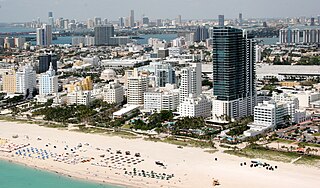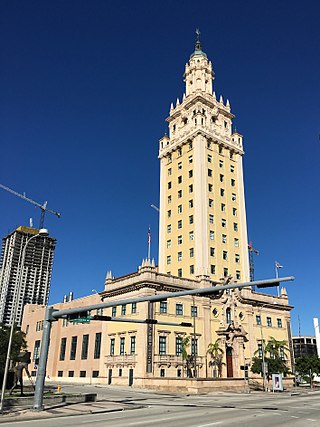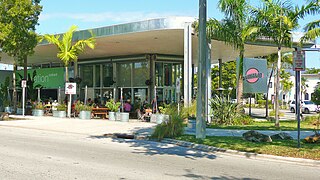
Miami Beach is a coastal resort city in Miami-Dade County, Florida, United States. It is part of the Miami metropolitan area of South Florida. The municipality is located on natural and human-made barrier islands between the Atlantic Ocean and Biscayne Bay, the latter of which separates the Beach from the mainland city of Miami. The neighborhood of South Beach, comprising the southernmost 2.5 sq mi (6.5 km2) of Miami Beach, along with Downtown Miami and the PortMiami, collectively form the commercial center of South Florida. Miami Beach's population is 82,890 according to the 2020 census. It has been one of America's preeminent beach resorts since the early 20th century.

The Freedom Tower is a building in Miami, Florida. It was designed by Schultze and Weaver and is currently used as a contemporary art museum and a central office to different disciplines in the arts associated with Miami Dade College. It is located at 600 Biscayne Boulevard on Miami Dade College's Wolfson Campus.

South Beach, also nicknamed colloquially as SoBe, is a neighborhood in Miami Beach, Florida. It is located east of Miami between Biscayne Bay and the Atlantic Ocean. The area encompasses Miami Beach south of Dade Boulevard.

Miracle Mile is a neighborhood in the city of Los Angeles, California.

Miami Modernist architecture, or MiMo, is a regional style of architecture that developed in South Florida during the post-war period. The style was internationally recognized as a regionalist response to the International Style. It can be seen in most of the larger Miami and Miami Beach resorts built after the Great Depression. Because MiMo styling was not just a response to international architectural movements but also to client demands, themes of glamour, fun, and material excess were added to otherwise stark, minimalist, and efficient styles of the era. The style can be most observed today in Middle and Upper Miami Beach along Collins Avenue, as well as along the Biscayne Boulevard corridor starting from around Midtown, through the Design District and into the Upper Eastside.

Lincoln Road Mall is a pedestrian road running east–west parallel between 16th Street and 17th Street in Miami Beach, Florida, United States. Once completely open to vehicular traffic, it now hosts a pedestrian mall replete with shops, restaurants, galleries, and other businesses between Washington Avenue with a traffic accessible street extending east to the Atlantic Ocean and west to Alton Road with a traffic accessible street extending to Biscayne Bay.

The Bay Shore Historic District is a U.S. historic district located in Miami, Florida. The district is bounded by Northeast 55th Street, Biscayne Boulevard, Northeast 60th Street and Biscayne Bay, in the Morningside section of the Upper Eastside neighborhood. It contains 223 historic buildings.

The Miami Beach Architectural District is a U.S. historic district located in the South Beach neighborhood of Miami Beach, Florida. The area is well known as the district where Italian fashion designer Gianni Versace lived and was assassinated by Andrew Cunanan, in a mansion on Ocean Drive. It is bounded by the Atlantic Ocean to the east, Sixth Street to the south, Alton Road to the west and the Collins Canal and Dade Boulevard to the north. It contains 960 historic buildings.

Downtown Miami is the urban city center of Miami, Florida, United States. The city's greater downtown region consists of the Central Business District, Brickell, the Historic District, Government Center, the Arts & Entertainment District, and Park West. It is divided by the Miami River and is bordered by Midtown Miami's Edgewater, and Wynwood sections to its north, Biscayne Bay to its east, the Health District and Overtown to its west, and Coconut Grove to its south.

Midtown Miami is the collective term for the Wynwood and Edgewater neighborhoods of Miami, Florida. It is located north of Downtown and south of the Miami Design District and is roughly bound by North 20th Street to the south, I-195 to the north, I-95 to the west, and Biscayne Bay to the east.

The Upper Eastside is a neighborhood in Miami, Florida. It is north of Edgewater, east of Little Haiti, south of the village of Miami Shores, and sits on Biscayne Bay. In geographical order from south to north and east to west, it contains the subdivisions of Magnolia Park, Bay Point, Morningside, Bayside, Belle Meade, Shorecrest, and Palm Grove. The MiMo District along Biscayne Boulevard in the area is host to many art galleries, shops and restaurants.

The following buildings were added to the National Register of Historic Places as part of the Downtown Miami Multiple Resources Area, a type of Multiple Property Submission (MPS).

The Arts & Entertainment District, or previously known as Omni, is a neighborhood of Downtown Miami, Florida. It is bound roughly by North 19th Street to the north, North 10th Street to the south, North West 2nd Avenue to the west, and Biscayne Boulevard to the east.

The Sears, Roebuck and Company Department Store in Miami, Florida was an Art Deco building built in 1929 for Sears, Roebuck and Company. The building was the first known implementation of Art Deco architecture in the county and was spectacular. It was followed a year later by the Shrine Building, an application of Art Deco with local Seminole Indian motifs added as an interesting twist. Both were covered in a 1988 study of Downtown Miami historic resources, but were not NRHP-listed due to owner objections at the time. It was listed on the National Register of Historic Places on August 8, 1997. Only its tower remains.

The architectural firm of Kiehnel and Elliott was established in Pittsburgh, Pennsylvania, in 1906. The firm did substantial work in Florida, and moved to Miami in 1922. From 1926, it was known as Kiehnel, Elliott and Chalfant.

Park West is a neighborhood of Greater Downtown, Miami, Florida. It is roughly bound by Biscayne Boulevard to the east, West (NW) First Avenue to the west, North (NE/NW) 7th Street to the south and Interstate 395 to the north. As of 2010, about 4,655 residents live in Park West. The neighborhood is named 'Park West' due to its location just west of Museum Park.

The Surfcomber Hotel is a boutique hotel on Collins Avenue in the historic Art Deco district of South Beach in Miami Beach, Florida. The hotel was built in 1948 and was acquired by the Kimpton hotel chain in April 2011. The Surfcomber is known for pool parties, and it served as the headquarters for MTV during the 2005 MTV Video Music Awards and for Bud Light during Super Bowl XLIV in 2010. The hotel is located at 1717 Collins Avenue on the shore of Miami's South Beach.

The Central Business District (CBD) of Miami is the historic central business district and city center of what has become Greater Downtown Miami in Florida. Over 92,000 people work in Miami's Central Business District.

Ace Theatre in Miami, Florida, is an Art Deco commercial structure constructed in 1930 in Miami's Coconut Grove neighborhood. On July 1, 2014, the site was designated as a local historic resource. The building was added to the National Register of Historic Places June 13, 2016.
B. Robert Swartburg was an American architect working in New York and Florida primarily known for his Modern and Streamline Moderne architectural style. He was one of the leading modernist architects in South Florida contributing greatly to the development of MiMo Modern style in the post- WWII 40s and 50's. In his 35-year career he is said to have designed over 1000 buildings. Swartburg was also an accomplished artist who painted for pleasure, and executed murals and sculptures to embellish his buildings.



















